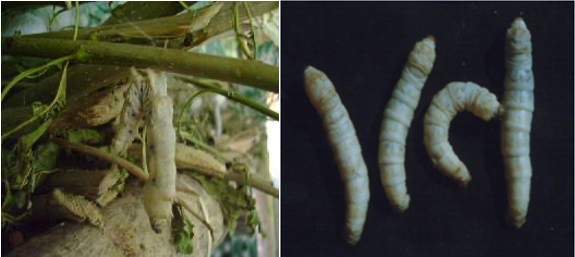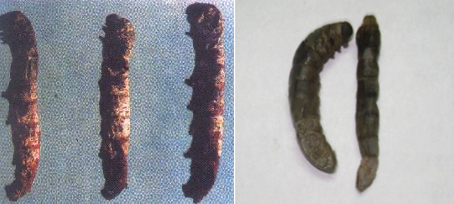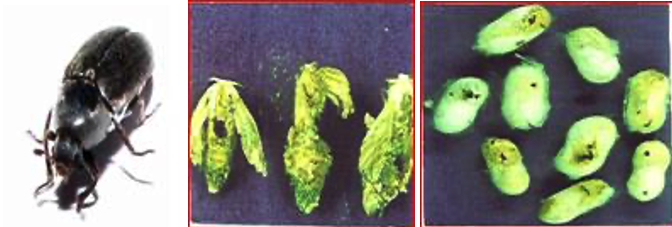🦠 Silkworms Pests
Learn about different diseases and insect-pests of Silkworm
Which of the following statement is correct?
👉🏻 Diseases of Mulberry Silkworm can be classified based on casual organism type:
- Protozoan Disease (Pebrine)
- Viral Disease (Grasserie)
- Bacterial Diseases (Flacherie)
- Fungal Diseases (Muscardine)
Pebrine (Protozoan Disease)
Pebrine Diseaseof silkworm is caused byprotozoan,Nosema bombycis.- It is a major disease of Munga Silkworms.
- Mother moth examination is done to check Pebrine disease.
- Diseases larvae show slow growth, undersized body and poor appetite.
- Diseases larvae reveal pale and flaccid body. Tiny black spots appear on larval integument.
- Pebrine is also called
pepperorcorpuscle diseasebecause of black pepper like spots that occur in the body of silkworm. - Dead larvae remain rubbery and do not undergo putrefaction shortly after death.

Grasserie (Viral Disease)

- Causative agent: Bombyx mori Nuclear Polyhedrosis Virus.
- The skin of worms becomes
shinybefore moulting and fails to moult. - The infected worms move
restlesslyalong the rim of the trays. - The inter segmental swelling appears and the color of the body becomes yellowish.
Bamboo canelike appearance of silkworm is the symptom of Grasserie (Jaundice) caused by Borrelina virus.- A destructive viral polyhedral disease of silkworm that is related to wilt and is marked by spotty yellowing of the skin and internal liquefaction also called
jaundicein silkworm.
Flacherie (Bacterial Disease)

- Causal organism:
Streptococci, orBacillusbacteria. - Bacteria and sometimes in combination with viruses cause the disease individually or in combination.
- Fluctuating temperature and humidity and poor quality mulberry predispose the disease development.
- The infected worms show loss of appetite.
- Head and thorax become translucent.
- Growth and development of the worms become irregular due to shrinkage of the body.
- Retarded growth, empty foregut and midgut.
- It is a major disease of silk worm.
- Flaccidity of larvae is major symptom.
- The
larvae vomit gut juice, develop dysentery anddiarrheawhich includes excretion of chain type feacus.
Muscardine (Fungal Diseases)

White Muscadineis caused by a fungus Beauveria bassianaGreen Muscadineis caused by a fungus Metarrhizium anisopliaeAspergillosisis common in young age silkworms and the infected larvae will be lustrous and die.- Dark green (Aspergillus flavus) or rusty brown (Aspergillus tamari) mycelial cluster are seen on the dead body.
- The diseases larvae prior to death will be lethargic and on death are flaccid.
- Oil specks may be seen on the surface of larvae.
- They gradually be fome hard, dry and
mummifyinto a white or green coloured structure. - The diseases pupae will be hard, lighter and mummifies.
Uzi Fly

- Exorista sorbillians
- 4th and 5th instar of silkworms are infested by Uzi fly.
- Presence of
black spotorscar in the body of silkwormorholes in cocconis due to the infestation of Uzi fly. - Occurrence & Symptom:
- The uzi fly, Exorista bombycis is a serious endo-larval parasitoid of the silkworm, Bombyx mori, inflicting 10-15% damage to the silkworm cocoon crop in the premier silk producing states of Karnataka, Andhra Pradesh and Tamil Nadu
- Uzi fly occurs throughout the year, but severe during rainy season. Presences of eggs or black scar on the silkworm body and maggot emergence hole at the tip of the cocoon are the typical symptoms of uzi fly attack.
- As soon as the uzi fly enters into rearing house, it lays one or two eggs on each silkworm larva. After 2-3 days, egg hatches, enters inside the larva and feed on internal contents for 5-7 days, after which it comes out by rupturing the larva. The maggot pupates in a dark corner or cracks & crevices in about 18-24 hours. The pupal stage lasts for 10-12 days. If the uzi fly infests at last instar, the uzi maggots come out after cocoon formation by making a circular hole.
Dermistid beetle

- Dermistid beetle (Dermestes cadeverinus) eat the coccons, enclosed pupae and eggs of silkworms.
- Occurrence & Symptom:
- Dermestid beetles, Dermestis ater are known to attack pierced cocoons in cocoon storage rooms.
- The female beetles lay about 150-250 eggs in the floss of cocoons.
- The beetles migrate from cocoon storage room to grainage and attack green cocoons as well as moths also.
- Generally they attack the abdominal region of the moth.
- The damage is estimated to be 16.62% on cocoons and 3.57% on moths.
References
- https://csb.gov.in/
- https://agritech.tnau.ac.in/
- Wikipedia
- https://sericulture.assam.gov.in/
- https://agritech.tnau.ac.in
- Central Sericulture Research & Training Institute, Mysore, Karnataka
- Package of Practices of Mulberry Sericulture for Eastern and North Eastern Region, Central Sericultural Research & Training Institute, Berhampore, West Bengal
Which of the following statement is correct?
👉🏻 Diseases of Mulberry Silkworm can be classified based on casual organism type:
- Protozoan Disease (Pebrine)
- Viral Disease (Grasserie)
- Bacterial Diseases (Flacherie)
- Fungal Diseases (Muscardine)
Pebrine (Protozoan Disease)
Pebrine Diseaseof silkworm is caused byprotozoan,Nosema bombycis.- It is a major disease of Munga Silkworms.
- Mother moth examination is done to check Pebrine disease.
- Diseases larvae show slow growth, undersized body and poor appetite.
- Diseases larvae reveal pale and flaccid body. Tiny black spots appear on larval integument.
- Pebrine is also called
pepperorcorpuscle diseasebecause of black pepper like spots that occur in the body of silkworm. - Dead larvae remain rubbery and do not undergo putrefaction shortly after …
Become Successful With AgriDots
Learn the essential skills for getting a seat in the Exam with
🦄 You are a pro member!
Only use this page if purchasing a gift or enterprise account
Plan
Rs
- Unlimited access to PRO courses
- Quizzes with hand-picked meme prizes
- Invite to private Discord chat
- Free Sticker emailed
Lifetime
Rs
1,499
once
- All PRO-tier benefits
- Single payment, lifetime access
- 4,200 bonus xp points
- Next Level
T-shirt shipped worldwide

Yo! You just found a 20% discount using 👉 EASTEREGG

High-quality fitted cotton shirt produced by Next Level Apparel